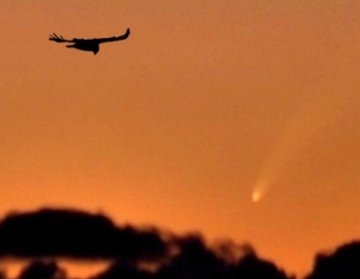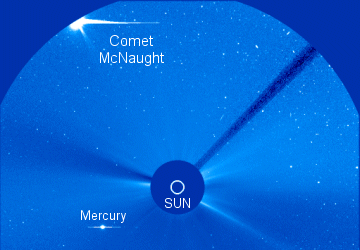 Did you sleep through the auroras of Dec. 14th? Next time get a wake-up call: Spaceweather PHONE.
Did you sleep through the auroras of Dec. 14th? Next time get a wake-up call: Spaceweather PHONE.
GREAT COMET: Comet McNaught is getting very close to the sun, right inside the glare of sunset. But you might be able to see it anyway, because this is the brightest comet in 30 years.
"I thought the comet would be very hard to see tonight--not so," says Mila Zinkova of San Francisco, California, on Jan. 11th. "I watched McNaught for a long time in the company of this hunting hawk."

Photo details: Canon XTI, 300mm lens, f5.6, iso100, exposure 1/13 sec
"The comet was much brighter this evening," agrees Chris Cook of Cape Cod, Massachusetts. "I picked it up with my eye only seven minutes after sunset on Jan. 11th. "I estimate the magnitude at around -3. Truly a view to remember: image."
Note to sky watchers: Having trouble finding the comet? Scan the sunset with binoculars. Once found, McNaught is easy to track. Do not try this, however, until the sun is safely below the horizon.
Comet McNaught Photo Gallery
[finder chart] [ephemeris] [3D orbit]
THE VIEW FROM SPACE: Here on Earth we struggle with the sunset. That's no problem for SOHO. The Solar and Heliospheric Observatory is in space and has a crystal-clear view of the sun 24 hours a day. Comet McNaught has just entered the spacecraft's field of view:

This image was captured by SOHO's coronagraph--a device that blocks the glare of the sun to reveal nearby stars, planets and comets. In the days ahead, Comet McNaught will slice across the scene, tail in full view, making a close encounter with Mercury on Jan. 14th. Stay tuned!
THIS JUST IN: NASA's STEREO-B spacecraft has also spotted Comet McNaught. Click here for images.

